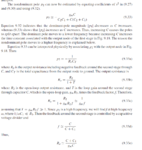tenso
Advanced Member level 4
I wanted some clarification as to the type of internal feedback present in the second common source gain stage in a 2 stage OTA where the gate and drain are connected with a miller capacitor. I thought it was shunt-shunt type of feedback but Gray-Meyer seems to say that it is series-shunt. I was reading the section where they try to derive the non-dominant pole by just observing the pole at the output and not solving the small-signal model's transfer function. I am attaching the page in chapter 9 of the fifth edition where they do this.

Here C is the miller capacitor. C1 is the shunt cap at output of first stage and C2 is the shunt cap at output of 2nd stage. Since the output resistance Ro is reduced by 1+T, we have shunt sensing at the output. The calculation of the feedback factor f tells me that that is series-shunt feedback.
but it seems to me that a current signal is being fed back into the input and that it is shunt-shunt? it seems that I am wrong but I was hoping someone could help me to see how it is series-shunt for the second common source stage.

Here C is the miller capacitor. C1 is the shunt cap at output of first stage and C2 is the shunt cap at output of 2nd stage. Since the output resistance Ro is reduced by 1+T, we have shunt sensing at the output. The calculation of the feedback factor f tells me that that is series-shunt feedback.
but it seems to me that a current signal is being fed back into the input and that it is shunt-shunt? it seems that I am wrong but I was hoping someone could help me to see how it is series-shunt for the second common source stage.